Comprehensive Risk Assessment Report on Management and Analysis
VerifiedAdded on 2024/05/31
|25
|4441
|480
Report
AI Summary
This risk assessment assignment provides a detailed analysis of various risk management concepts, including the differences between proactive and reactive risk management, the risk management process, and the main types and sources of risk in an organization. It delves into the significance of risks, explaining the distinction between general and operational risks and how to determine if a risk is under successful control. The report also differentiates between a risk management system and a systemic approach to risk management, summarizing the necessary content of a risk management system. Furthermore, it critically evaluates the LTIFR measure, discusses the preference for lower loss and risk costs with higher risk control costs in the context of TCOR, and includes a risk analysis using a mechanism analysis logic diagram and an outcome analysis diagram.
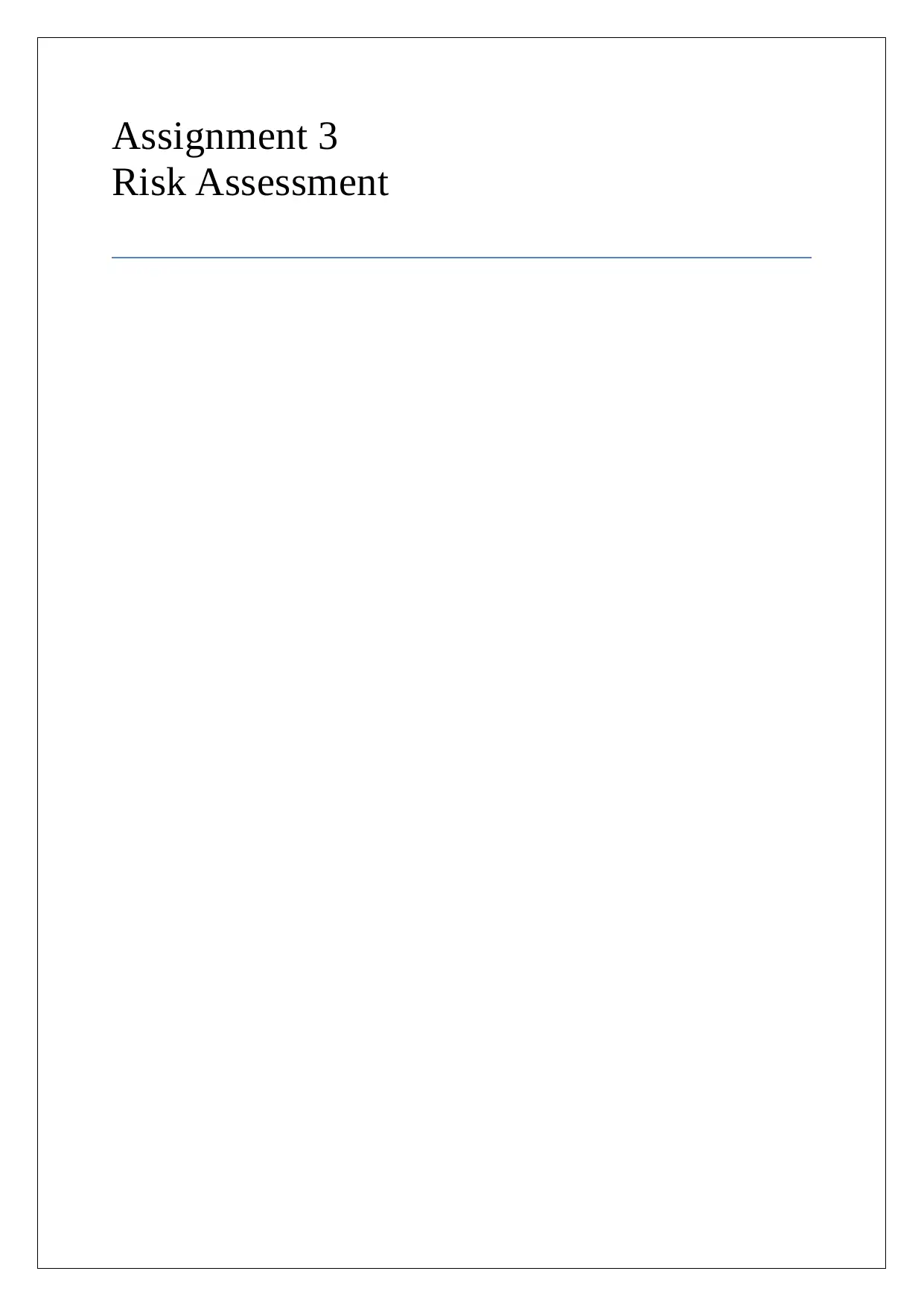
Assignment 3
Risk Assessment
Risk Assessment
Paraphrase This Document
Need a fresh take? Get an instant paraphrase of this document with our AI Paraphraser
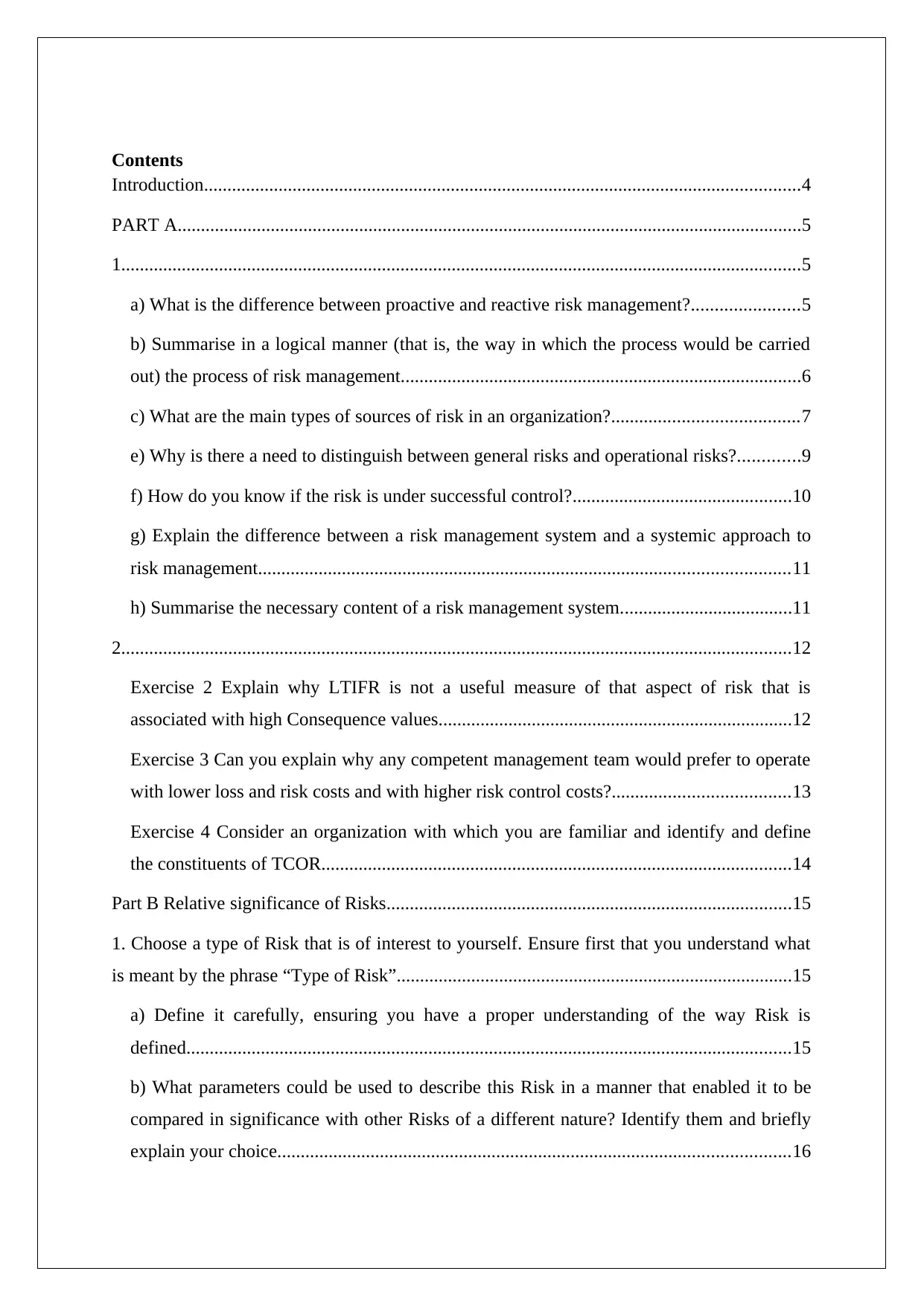
Contents
Introduction................................................................................................................................4
PART A......................................................................................................................................5
1..................................................................................................................................................5
a) What is the difference between proactive and reactive risk management?.......................5
b) Summarise in a logical manner (that is, the way in which the process would be carried
out) the process of risk management......................................................................................6
c) What are the main types of sources of risk in an organization?........................................7
e) Why is there a need to distinguish between general risks and operational risks?.............9
f) How do you know if the risk is under successful control?...............................................10
g) Explain the difference between a risk management system and a systemic approach to
risk management..................................................................................................................11
h) Summarise the necessary content of a risk management system.....................................11
2................................................................................................................................................12
Exercise 2 Explain why LTIFR is not a useful measure of that aspect of risk that is
associated with high Consequence values............................................................................12
Exercise 3 Can you explain why any competent management team would prefer to operate
with lower loss and risk costs and with higher risk control costs?......................................13
Exercise 4 Consider an organization with which you are familiar and identify and define
the constituents of TCOR.....................................................................................................14
Part B Relative significance of Risks.......................................................................................15
1. Choose a type of Risk that is of interest to yourself. Ensure first that you understand what
is meant by the phrase “Type of Risk”.....................................................................................15
a) Define it carefully, ensuring you have a proper understanding of the way Risk is
defined..................................................................................................................................15
b) What parameters could be used to describe this Risk in a manner that enabled it to be
compared in significance with other Risks of a different nature? Identify them and briefly
explain your choice..............................................................................................................16
Introduction................................................................................................................................4
PART A......................................................................................................................................5
1..................................................................................................................................................5
a) What is the difference between proactive and reactive risk management?.......................5
b) Summarise in a logical manner (that is, the way in which the process would be carried
out) the process of risk management......................................................................................6
c) What are the main types of sources of risk in an organization?........................................7
e) Why is there a need to distinguish between general risks and operational risks?.............9
f) How do you know if the risk is under successful control?...............................................10
g) Explain the difference between a risk management system and a systemic approach to
risk management..................................................................................................................11
h) Summarise the necessary content of a risk management system.....................................11
2................................................................................................................................................12
Exercise 2 Explain why LTIFR is not a useful measure of that aspect of risk that is
associated with high Consequence values............................................................................12
Exercise 3 Can you explain why any competent management team would prefer to operate
with lower loss and risk costs and with higher risk control costs?......................................13
Exercise 4 Consider an organization with which you are familiar and identify and define
the constituents of TCOR.....................................................................................................14
Part B Relative significance of Risks.......................................................................................15
1. Choose a type of Risk that is of interest to yourself. Ensure first that you understand what
is meant by the phrase “Type of Risk”.....................................................................................15
a) Define it carefully, ensuring you have a proper understanding of the way Risk is
defined..................................................................................................................................15
b) What parameters could be used to describe this Risk in a manner that enabled it to be
compared in significance with other Risks of a different nature? Identify them and briefly
explain your choice..............................................................................................................16
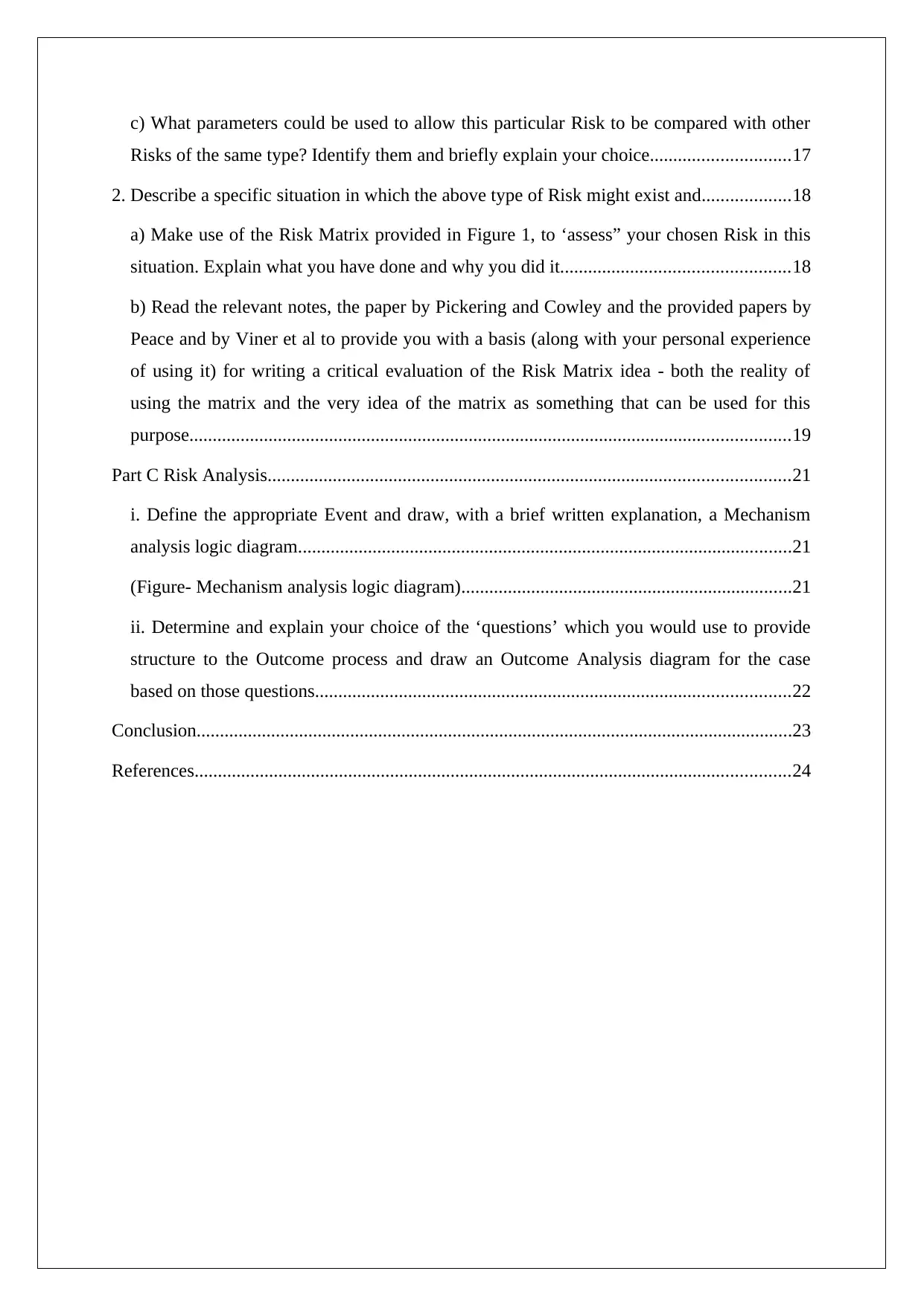
c) What parameters could be used to allow this particular Risk to be compared with other
Risks of the same type? Identify them and briefly explain your choice..............................17
2. Describe a specific situation in which the above type of Risk might exist and...................18
a) Make use of the Risk Matrix provided in Figure 1, to ‘assess” your chosen Risk in this
situation. Explain what you have done and why you did it.................................................18
b) Read the relevant notes, the paper by Pickering and Cowley and the provided papers by
Peace and by Viner et al to provide you with a basis (along with your personal experience
of using it) for writing a critical evaluation of the Risk Matrix idea - both the reality of
using the matrix and the very idea of the matrix as something that can be used for this
purpose.................................................................................................................................19
Part C Risk Analysis................................................................................................................21
i. Define the appropriate Event and draw, with a brief written explanation, a Mechanism
analysis logic diagram..........................................................................................................21
(Figure- Mechanism analysis logic diagram).......................................................................21
ii. Determine and explain your choice of the ‘questions’ which you would use to provide
structure to the Outcome process and draw an Outcome Analysis diagram for the case
based on those questions......................................................................................................22
Conclusion................................................................................................................................23
References................................................................................................................................24
Risks of the same type? Identify them and briefly explain your choice..............................17
2. Describe a specific situation in which the above type of Risk might exist and...................18
a) Make use of the Risk Matrix provided in Figure 1, to ‘assess” your chosen Risk in this
situation. Explain what you have done and why you did it.................................................18
b) Read the relevant notes, the paper by Pickering and Cowley and the provided papers by
Peace and by Viner et al to provide you with a basis (along with your personal experience
of using it) for writing a critical evaluation of the Risk Matrix idea - both the reality of
using the matrix and the very idea of the matrix as something that can be used for this
purpose.................................................................................................................................19
Part C Risk Analysis................................................................................................................21
i. Define the appropriate Event and draw, with a brief written explanation, a Mechanism
analysis logic diagram..........................................................................................................21
(Figure- Mechanism analysis logic diagram).......................................................................21
ii. Determine and explain your choice of the ‘questions’ which you would use to provide
structure to the Outcome process and draw an Outcome Analysis diagram for the case
based on those questions......................................................................................................22
Conclusion................................................................................................................................23
References................................................................................................................................24
⊘ This is a preview!⊘
Do you want full access?
Subscribe today to unlock all pages.

Trusted by 1+ million students worldwide
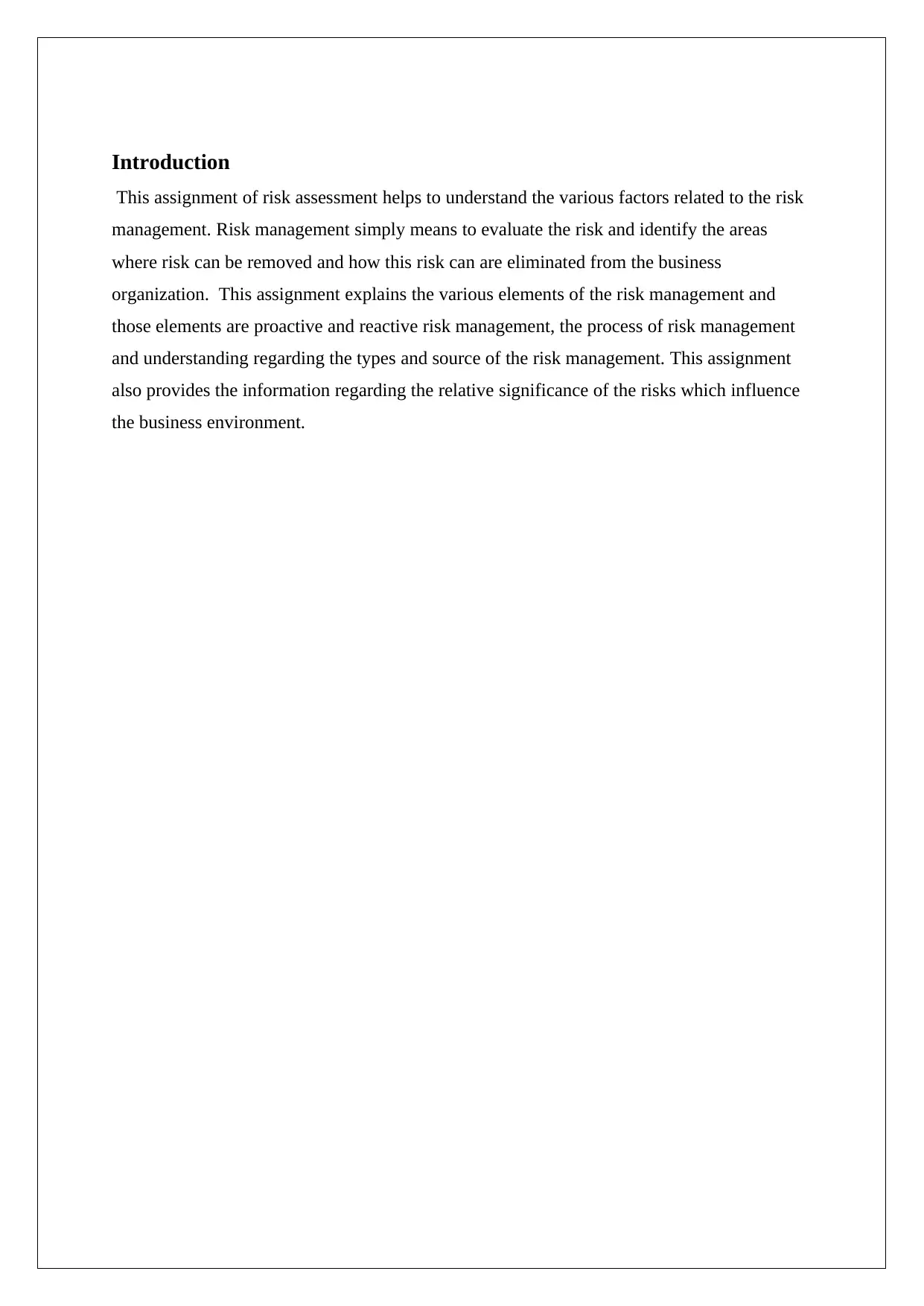
Introduction
This assignment of risk assessment helps to understand the various factors related to the risk
management. Risk management simply means to evaluate the risk and identify the areas
where risk can be removed and how this risk can are eliminated from the business
organization. This assignment explains the various elements of the risk management and
those elements are proactive and reactive risk management, the process of risk management
and understanding regarding the types and source of the risk management. This assignment
also provides the information regarding the relative significance of the risks which influence
the business environment.
This assignment of risk assessment helps to understand the various factors related to the risk
management. Risk management simply means to evaluate the risk and identify the areas
where risk can be removed and how this risk can are eliminated from the business
organization. This assignment explains the various elements of the risk management and
those elements are proactive and reactive risk management, the process of risk management
and understanding regarding the types and source of the risk management. This assignment
also provides the information regarding the relative significance of the risks which influence
the business environment.
Paraphrase This Document
Need a fresh take? Get an instant paraphrase of this document with our AI Paraphraser
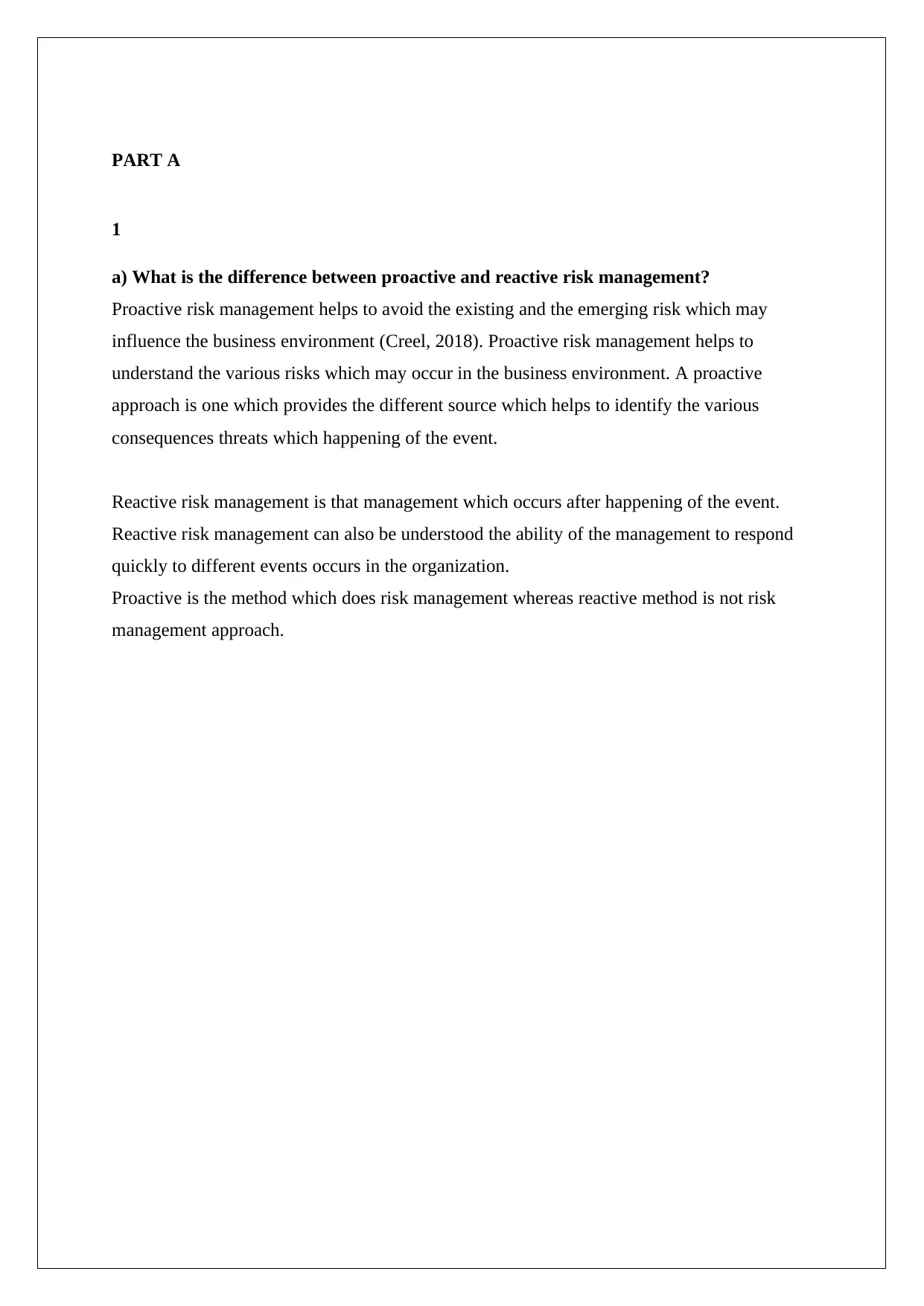
PART A
1
a) What is the difference between proactive and reactive risk management?
Proactive risk management helps to avoid the existing and the emerging risk which may
influence the business environment (Creel, 2018). Proactive risk management helps to
understand the various risks which may occur in the business environment. A proactive
approach is one which provides the different source which helps to identify the various
consequences threats which happening of the event.
Reactive risk management is that management which occurs after happening of the event.
Reactive risk management can also be understood the ability of the management to respond
quickly to different events occurs in the organization.
Proactive is the method which does risk management whereas reactive method is not risk
management approach.
1
a) What is the difference between proactive and reactive risk management?
Proactive risk management helps to avoid the existing and the emerging risk which may
influence the business environment (Creel, 2018). Proactive risk management helps to
understand the various risks which may occur in the business environment. A proactive
approach is one which provides the different source which helps to identify the various
consequences threats which happening of the event.
Reactive risk management is that management which occurs after happening of the event.
Reactive risk management can also be understood the ability of the management to respond
quickly to different events occurs in the organization.
Proactive is the method which does risk management whereas reactive method is not risk
management approach.
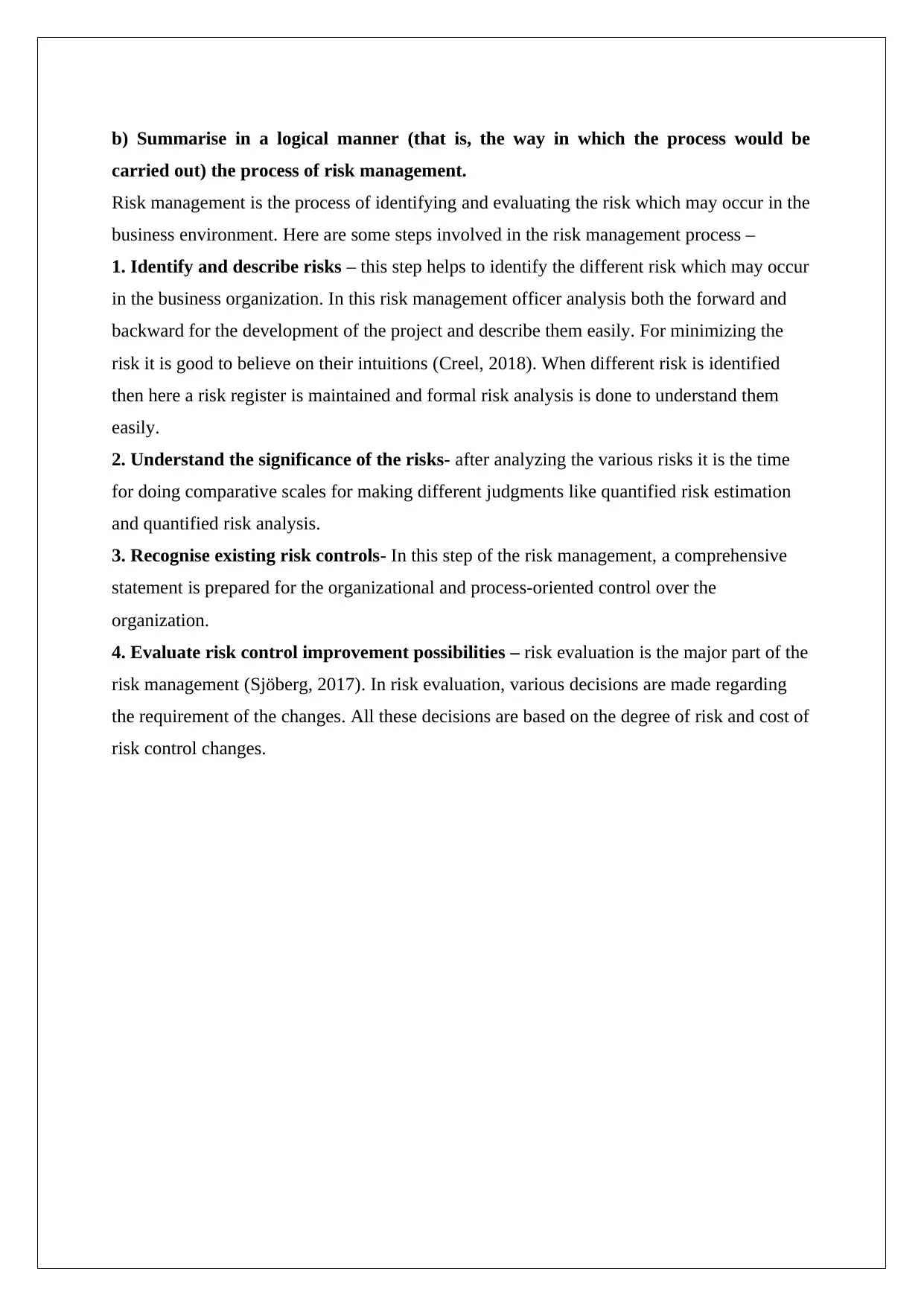
b) Summarise in a logical manner (that is, the way in which the process would be
carried out) the process of risk management.
Risk management is the process of identifying and evaluating the risk which may occur in the
business environment. Here are some steps involved in the risk management process –
1. Identify and describe risks – this step helps to identify the different risk which may occur
in the business organization. In this risk management officer analysis both the forward and
backward for the development of the project and describe them easily. For minimizing the
risk it is good to believe on their intuitions (Creel, 2018). When different risk is identified
then here a risk register is maintained and formal risk analysis is done to understand them
easily.
2. Understand the significance of the risks- after analyzing the various risks it is the time
for doing comparative scales for making different judgments like quantified risk estimation
and quantified risk analysis.
3. Recognise existing risk controls- In this step of the risk management, a comprehensive
statement is prepared for the organizational and process-oriented control over the
organization.
4. Evaluate risk control improvement possibilities – risk evaluation is the major part of the
risk management (Sjöberg, 2017). In risk evaluation, various decisions are made regarding
the requirement of the changes. All these decisions are based on the degree of risk and cost of
risk control changes.
carried out) the process of risk management.
Risk management is the process of identifying and evaluating the risk which may occur in the
business environment. Here are some steps involved in the risk management process –
1. Identify and describe risks – this step helps to identify the different risk which may occur
in the business organization. In this risk management officer analysis both the forward and
backward for the development of the project and describe them easily. For minimizing the
risk it is good to believe on their intuitions (Creel, 2018). When different risk is identified
then here a risk register is maintained and formal risk analysis is done to understand them
easily.
2. Understand the significance of the risks- after analyzing the various risks it is the time
for doing comparative scales for making different judgments like quantified risk estimation
and quantified risk analysis.
3. Recognise existing risk controls- In this step of the risk management, a comprehensive
statement is prepared for the organizational and process-oriented control over the
organization.
4. Evaluate risk control improvement possibilities – risk evaluation is the major part of the
risk management (Sjöberg, 2017). In risk evaluation, various decisions are made regarding
the requirement of the changes. All these decisions are based on the degree of risk and cost of
risk control changes.
⊘ This is a preview!⊘
Do you want full access?
Subscribe today to unlock all pages.

Trusted by 1+ million students worldwide
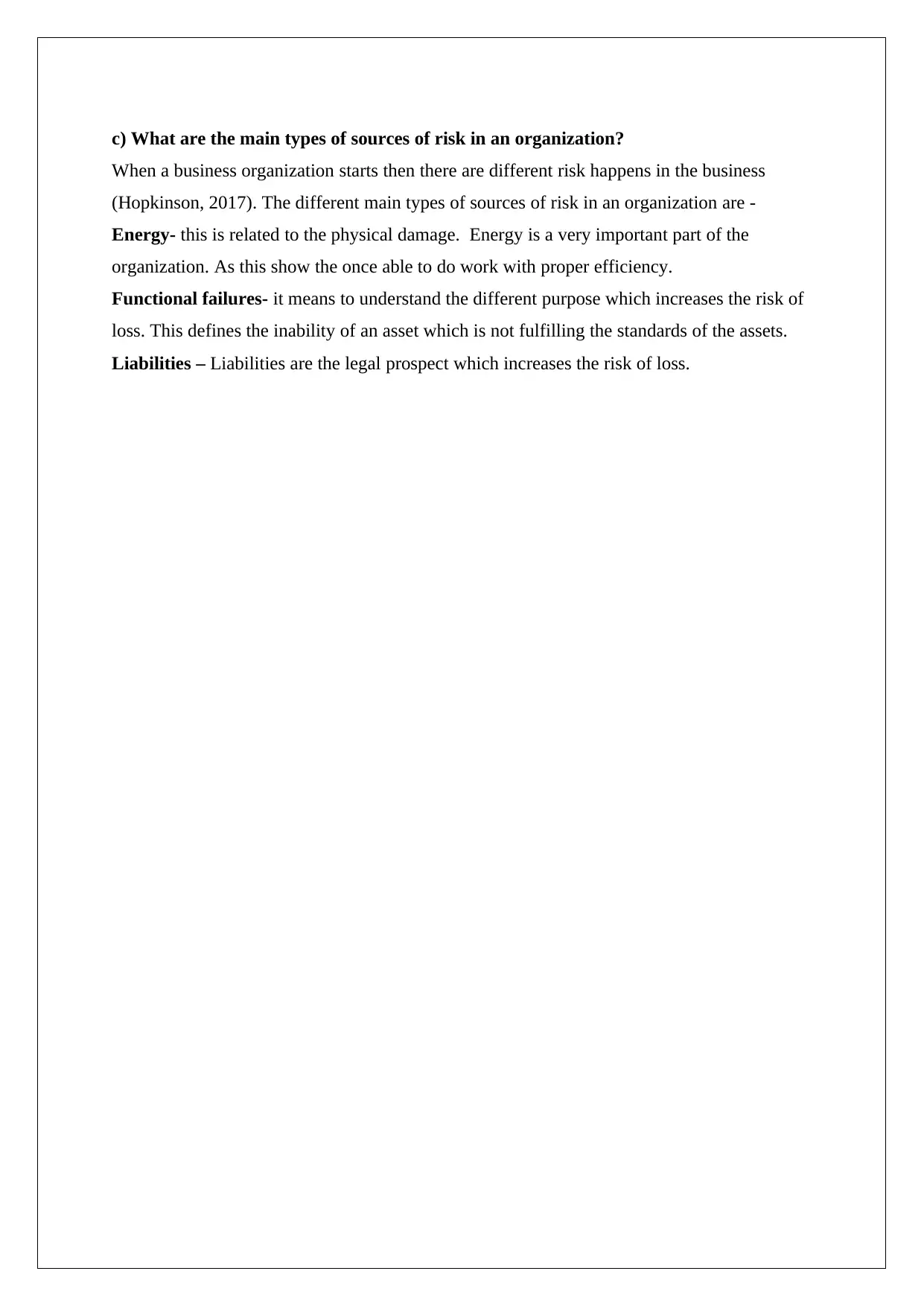
c) What are the main types of sources of risk in an organization?
When a business organization starts then there are different risk happens in the business
(Hopkinson, 2017). The different main types of sources of risk in an organization are -
Energy- this is related to the physical damage. Energy is a very important part of the
organization. As this show the once able to do work with proper efficiency.
Functional failures- it means to understand the different purpose which increases the risk of
loss. This defines the inability of an asset which is not fulfilling the standards of the assets.
Liabilities – Liabilities are the legal prospect which increases the risk of loss.
When a business organization starts then there are different risk happens in the business
(Hopkinson, 2017). The different main types of sources of risk in an organization are -
Energy- this is related to the physical damage. Energy is a very important part of the
organization. As this show the once able to do work with proper efficiency.
Functional failures- it means to understand the different purpose which increases the risk of
loss. This defines the inability of an asset which is not fulfilling the standards of the assets.
Liabilities – Liabilities are the legal prospect which increases the risk of loss.
Paraphrase This Document
Need a fresh take? Get an instant paraphrase of this document with our AI Paraphraser
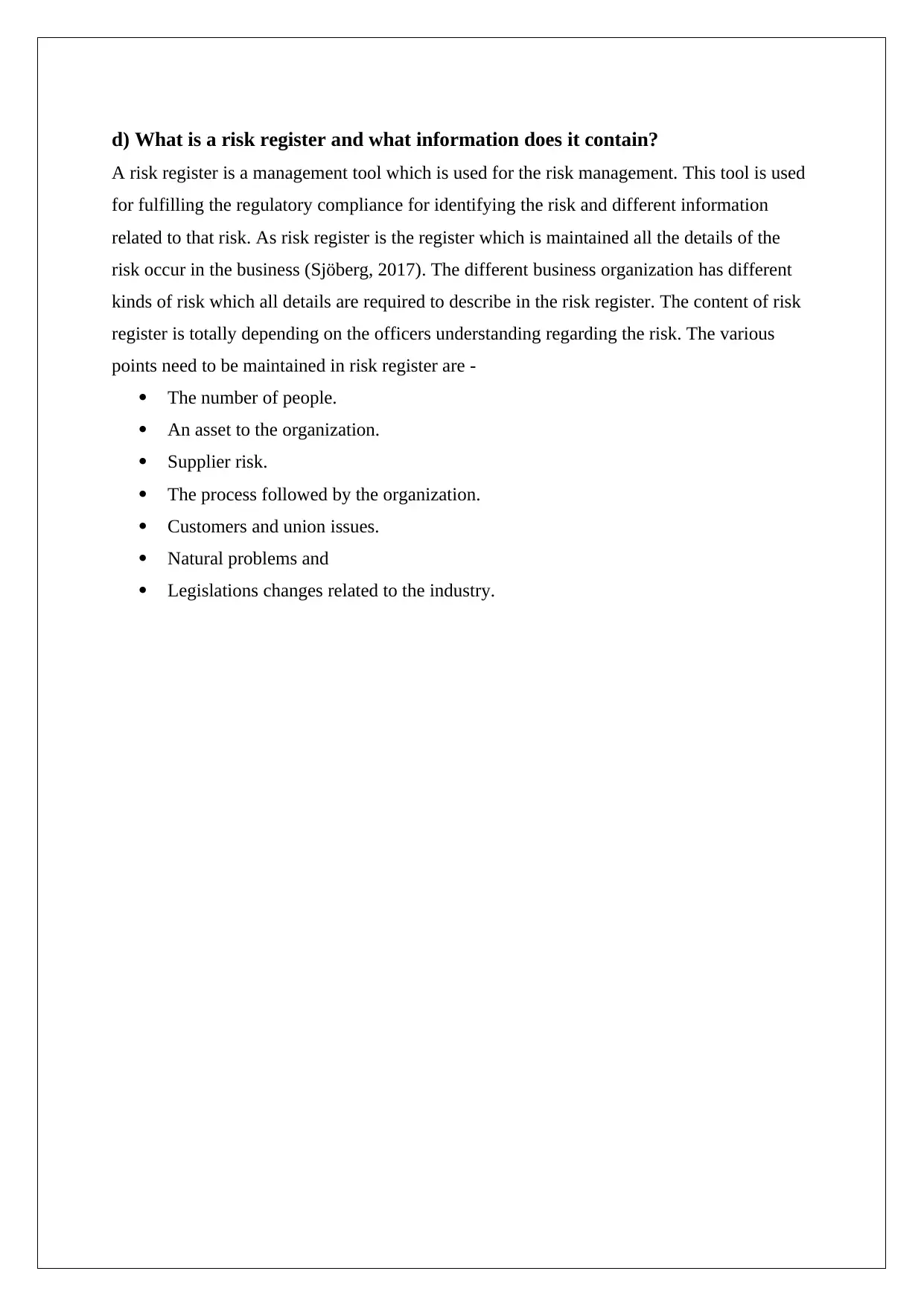
d) What is a risk register and what information does it contain?
A risk register is a management tool which is used for the risk management. This tool is used
for fulfilling the regulatory compliance for identifying the risk and different information
related to that risk. As risk register is the register which is maintained all the details of the
risk occur in the business (Sjöberg, 2017). The different business organization has different
kinds of risk which all details are required to describe in the risk register. The content of risk
register is totally depending on the officers understanding regarding the risk. The various
points need to be maintained in risk register are -
The number of people.
An asset to the organization.
Supplier risk.
The process followed by the organization.
Customers and union issues.
Natural problems and
Legislations changes related to the industry.
A risk register is a management tool which is used for the risk management. This tool is used
for fulfilling the regulatory compliance for identifying the risk and different information
related to that risk. As risk register is the register which is maintained all the details of the
risk occur in the business (Sjöberg, 2017). The different business organization has different
kinds of risk which all details are required to describe in the risk register. The content of risk
register is totally depending on the officers understanding regarding the risk. The various
points need to be maintained in risk register are -
The number of people.
An asset to the organization.
Supplier risk.
The process followed by the organization.
Customers and union issues.
Natural problems and
Legislations changes related to the industry.
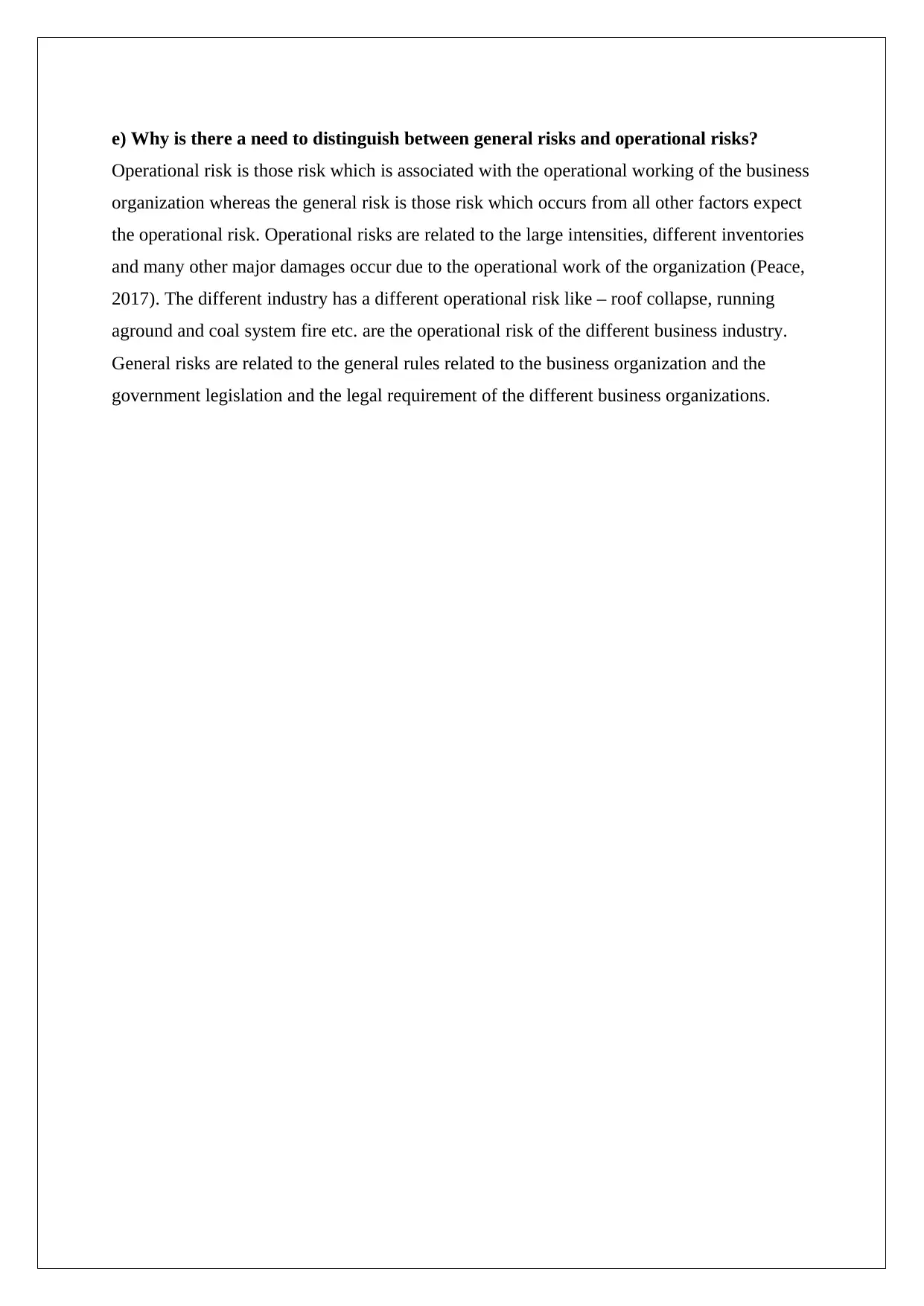
e) Why is there a need to distinguish between general risks and operational risks?
Operational risk is those risk which is associated with the operational working of the business
organization whereas the general risk is those risk which occurs from all other factors expect
the operational risk. Operational risks are related to the large intensities, different inventories
and many other major damages occur due to the operational work of the organization (Peace,
2017). The different industry has a different operational risk like – roof collapse, running
aground and coal system fire etc. are the operational risk of the different business industry.
General risks are related to the general rules related to the business organization and the
government legislation and the legal requirement of the different business organizations.
Operational risk is those risk which is associated with the operational working of the business
organization whereas the general risk is those risk which occurs from all other factors expect
the operational risk. Operational risks are related to the large intensities, different inventories
and many other major damages occur due to the operational work of the organization (Peace,
2017). The different industry has a different operational risk like – roof collapse, running
aground and coal system fire etc. are the operational risk of the different business industry.
General risks are related to the general rules related to the business organization and the
government legislation and the legal requirement of the different business organizations.
⊘ This is a preview!⊘
Do you want full access?
Subscribe today to unlock all pages.

Trusted by 1+ million students worldwide
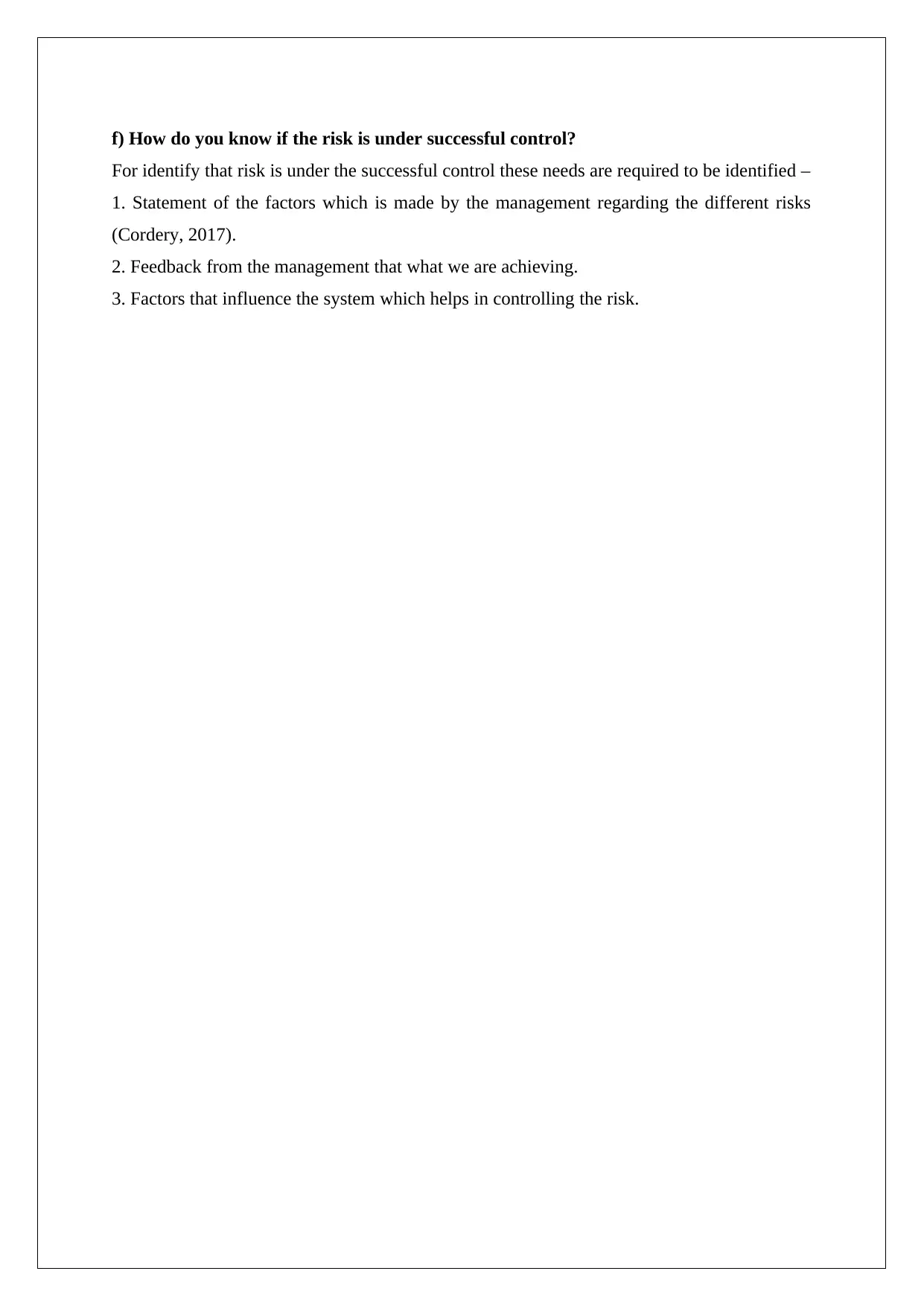
f) How do you know if the risk is under successful control?
For identify that risk is under the successful control these needs are required to be identified –
1. Statement of the factors which is made by the management regarding the different risks
(Cordery, 2017).
2. Feedback from the management that what we are achieving.
3. Factors that influence the system which helps in controlling the risk.
For identify that risk is under the successful control these needs are required to be identified –
1. Statement of the factors which is made by the management regarding the different risks
(Cordery, 2017).
2. Feedback from the management that what we are achieving.
3. Factors that influence the system which helps in controlling the risk.
Paraphrase This Document
Need a fresh take? Get an instant paraphrase of this document with our AI Paraphraser
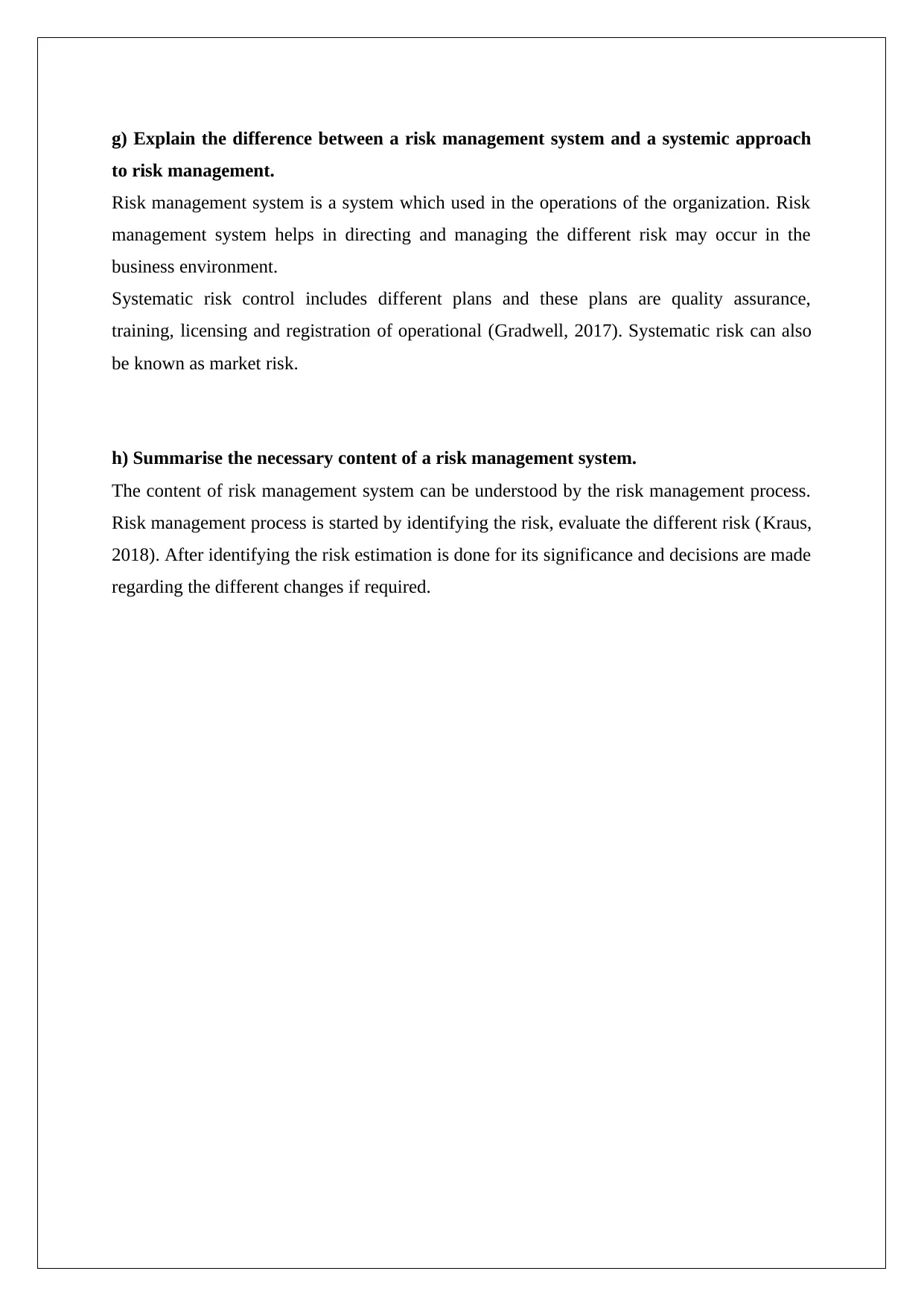
g) Explain the difference between a risk management system and a systemic approach
to risk management.
Risk management system is a system which used in the operations of the organization. Risk
management system helps in directing and managing the different risk may occur in the
business environment.
Systematic risk control includes different plans and these plans are quality assurance,
training, licensing and registration of operational (Gradwell, 2017). Systematic risk can also
be known as market risk.
h) Summarise the necessary content of a risk management system.
The content of risk management system can be understood by the risk management process.
Risk management process is started by identifying the risk, evaluate the different risk (Kraus,
2018). After identifying the risk estimation is done for its significance and decisions are made
regarding the different changes if required.
to risk management.
Risk management system is a system which used in the operations of the organization. Risk
management system helps in directing and managing the different risk may occur in the
business environment.
Systematic risk control includes different plans and these plans are quality assurance,
training, licensing and registration of operational (Gradwell, 2017). Systematic risk can also
be known as market risk.
h) Summarise the necessary content of a risk management system.
The content of risk management system can be understood by the risk management process.
Risk management process is started by identifying the risk, evaluate the different risk (Kraus,
2018). After identifying the risk estimation is done for its significance and decisions are made
regarding the different changes if required.
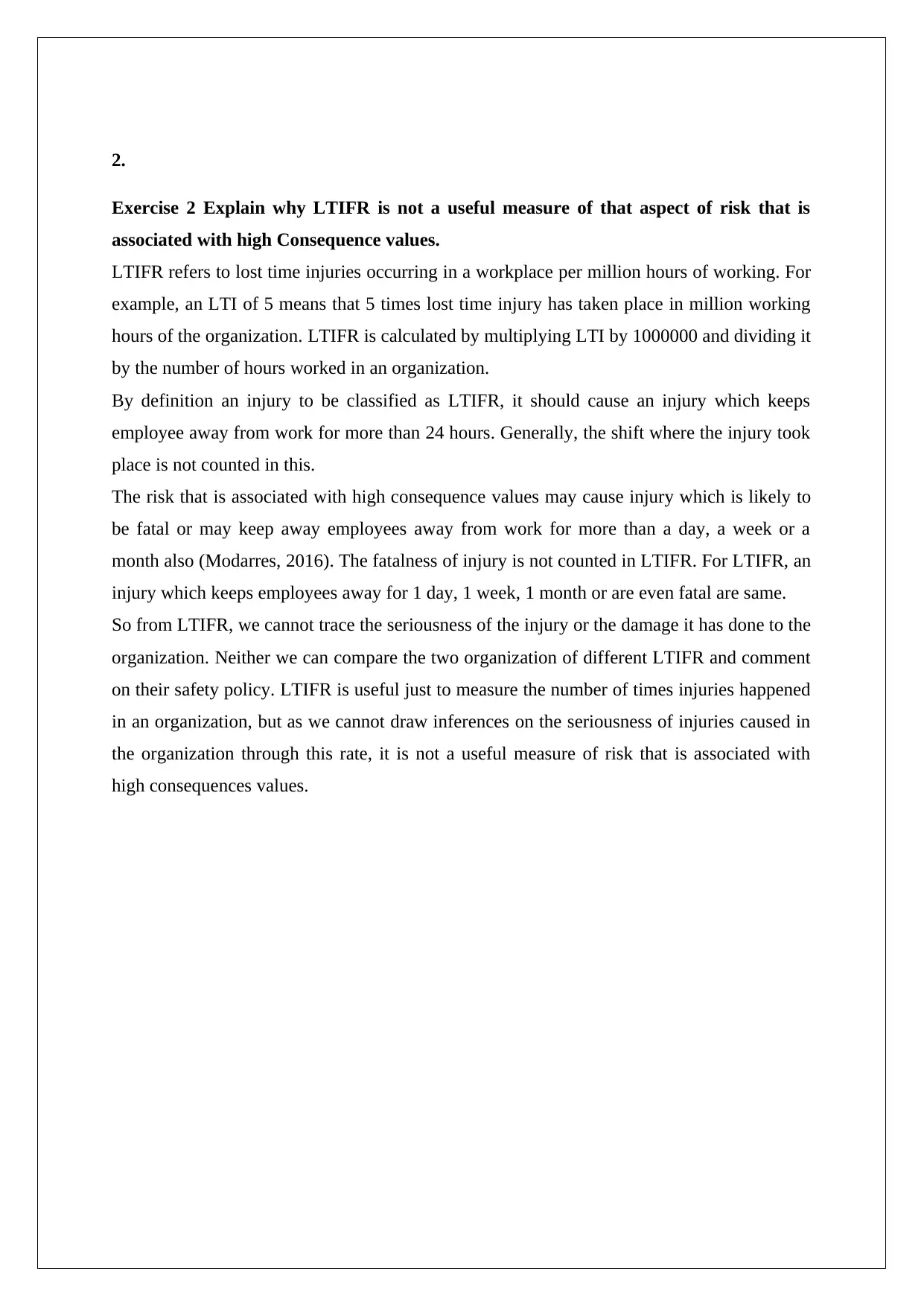
2.
Exercise 2 Explain why LTIFR is not a useful measure of that aspect of risk that is
associated with high Consequence values.
LTIFR refers to lost time injuries occurring in a workplace per million hours of working. For
example, an LTI of 5 means that 5 times lost time injury has taken place in million working
hours of the organization. LTIFR is calculated by multiplying LTI by 1000000 and dividing it
by the number of hours worked in an organization.
By definition an injury to be classified as LTIFR, it should cause an injury which keeps
employee away from work for more than 24 hours. Generally, the shift where the injury took
place is not counted in this.
The risk that is associated with high consequence values may cause injury which is likely to
be fatal or may keep away employees away from work for more than a day, a week or a
month also (Modarres, 2016). The fatalness of injury is not counted in LTIFR. For LTIFR, an
injury which keeps employees away for 1 day, 1 week, 1 month or are even fatal are same.
So from LTIFR, we cannot trace the seriousness of the injury or the damage it has done to the
organization. Neither we can compare the two organization of different LTIFR and comment
on their safety policy. LTIFR is useful just to measure the number of times injuries happened
in an organization, but as we cannot draw inferences on the seriousness of injuries caused in
the organization through this rate, it is not a useful measure of risk that is associated with
high consequences values.
Exercise 2 Explain why LTIFR is not a useful measure of that aspect of risk that is
associated with high Consequence values.
LTIFR refers to lost time injuries occurring in a workplace per million hours of working. For
example, an LTI of 5 means that 5 times lost time injury has taken place in million working
hours of the organization. LTIFR is calculated by multiplying LTI by 1000000 and dividing it
by the number of hours worked in an organization.
By definition an injury to be classified as LTIFR, it should cause an injury which keeps
employee away from work for more than 24 hours. Generally, the shift where the injury took
place is not counted in this.
The risk that is associated with high consequence values may cause injury which is likely to
be fatal or may keep away employees away from work for more than a day, a week or a
month also (Modarres, 2016). The fatalness of injury is not counted in LTIFR. For LTIFR, an
injury which keeps employees away for 1 day, 1 week, 1 month or are even fatal are same.
So from LTIFR, we cannot trace the seriousness of the injury or the damage it has done to the
organization. Neither we can compare the two organization of different LTIFR and comment
on their safety policy. LTIFR is useful just to measure the number of times injuries happened
in an organization, but as we cannot draw inferences on the seriousness of injuries caused in
the organization through this rate, it is not a useful measure of risk that is associated with
high consequences values.
⊘ This is a preview!⊘
Do you want full access?
Subscribe today to unlock all pages.

Trusted by 1+ million students worldwide
1 out of 25
Related Documents
Your All-in-One AI-Powered Toolkit for Academic Success.
+13062052269
info@desklib.com
Available 24*7 on WhatsApp / Email
![[object Object]](/_next/static/media/star-bottom.7253800d.svg)
Unlock your academic potential
Copyright © 2020–2025 A2Z Services. All Rights Reserved. Developed and managed by ZUCOL.





